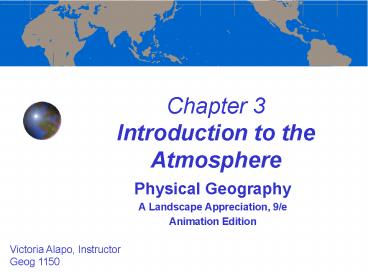Chapter 3 Introduction to the Atmosphere - PowerPoint PPT Presentation
Title:
Chapter 3 Introduction to the Atmosphere
Description:
Chapter 3 Introduction to the Atmosphere Physical Geography A Landscape Appreciation, 9/e Animation Edition Victoria Alapo, Instructor Geog 1150 Introduction to the ... – PowerPoint PPT presentation
Number of Views:417
Avg rating:3.0/5.0
Title: Chapter 3 Introduction to the Atmosphere
1
Chapter 3 Introduction to the Atmosphere
- Physical Geography
- A Landscape Appreciation, 9/e
- Animation Edition
Victoria Alapo, Instructor Geog 1150
2
Introduction to the Atmosphere
- Composition of the Atmosphere
- Vertical Structure of the Atmosphere
- The Ozone Problem
- Weather and Climate
- The Coriolis Effect
3
Composition of the Atmosphere
- Gases
- Particulates
- The gases that make up air.
- Permanent and variable gases, pg 56.
- some of these are greenhouse gases.
4
Atmospheric Particulates (Aerosols)
- Tiny solid and liquid particles (non-gaseous
particles) - - Effects on weather and climate
- Sources include (natural human)
- Ice, pollen, volcanic ash, salt sprayed by
oceans, wind-blown soil, meteor debris, smoke
from wild-fires. - Emissions (auto factories), soot, etc
- They affect weather and climate in 2 ways
- - they are hygroscopic, i.e. they attract water,
so water molecules form around them. - they can decrease the amt of solar energy
reaching Earth, like ash during a volcanic
eruption (see Pompei pictures).
Fig. 3-4, pg 57
5
Vertical Structure of the Atmosphere
- Temperature
- Pressure
- Composition
6
Thermal Layers of the Atmosphere
- Know how temperatures increase or decrease in
each layer. Pg 58 - The top of each layer ends with a pause.
7
- Troposphere
- Our weather occurs here
- Fig. 3-6a and b pg 59
8
Atmospheric Pressure
- Pressure
- Decreases with increasing altitude, pg 60
9
- Table 3-2 Atmospheric Pressure at Various
Altitudes (Expressed as a percentage of sea-level
pressure)
- Air pressure decreases with increasing altitude
but not at a constant rate
10
Atmospheric Composition
- Homosphere
- Zone of uniform distribution of gases (think pie
graph on first slide) - Heterosphere
- - Zone of layers
- - Gases are in layers according to molecular
weights
11
- Special layers
- Ozonosphere the ozone layer, 9 to 30 miles up.
Although not only ozone is found here. Pg 61. - Ionosphere layer of electrically charged
molecules atoms (ions). 40 to 250 miles up.
Impt for radio waves.
Fig. 3-10 Aurora Borealis in the Ionosphere
- Fig. 3-11
12
Vertical Structure of the Atmosphere
13
The Ozone Problem
- Natural Atmospheric Ozone
- Destruction of Ozone by Chlorofluorocarbons
(CFCs) - The Antarctic Ozone Hole, pg 64
14
Natural Ozone
15
Ozone Destruction by CFCs
16
Weather and Climate
- Weather describes temporary atmospheric
conditions e.g. current temperature,
precipitation, wind speed, etc. for a short
period of time. - On the other hand, Climate is the aggregate of
weather conditions, usually over a long period of
at least 30 years. - So weather climate are related but not
synonymous. - Elements of Weather and Climate
- Controls of Weather and Climate
17
Elements of Weather and Climate
Elements used for measuring weather climate
18
Controls of Weather and Climate
- The reasons why weather climate vary all over
earth. - Although each is discussed separately, theres a
lot of overlap in real life. - See next slides.
19
Latitude and Available Solar Energy
Long vs. short rays
20
Distribution of Land Water
- Oceans heat cool more slowly than landmasses.
- Maritime (coastal areas) experience milder
temperatures than continental areas, in both
summer winter. - E.g. Seattle, WA vs. Fargo, ND.
21
General Circulation of the Atmosphere
22
General Circulation of the Oceans
Transfers heat and cool water around the globe,
and affects neighboring continents. E.g. The
coast of Namibia (Africa) is cold, in spite of
its latitude.
23
Elevation (Altitude)
The higher you go, the cooler it becomes, and
vice-versa (at least in the troposphere).
24
Topographic Barriers
See caption, pg 69. Differences on the same
island!
25
(No Transcript)
26
(No Transcript)
27
Storms
They create specialized weather conditions, so
they are regarded as a control.
28
- The Coriolis Effect
- Because of the Earths rotation, any object
moving freely tends to be deflected to the right
in the Northern Hemisphere, to the left in the
Southern Hemisphere - Significance
- Winds
- Ocean currents
- Airplanes, missiles, and even ships, pg 70-71.
- Animation
- Fig. 3-23, showing planned route of wind, and
actual movement.
29
- Coriolis Effect (Summary)
- Definition
- An apparent deflection of any freely moving
object from its expected (straight) path - Four basic points to note
- Apparent deflection is to the right in the
Northern Hemisphere, to the left in the Southern
Hemisphere. - Apparent deflection is greatest at the poles,
progressively less toward the equator, where
there is zero deflection. - The effect is proportional to the speed of the
object, so a fast-moving object is deflected more
than a slower one. - The effect influences the direction of movement,
not the speed. - It seems to not have an effect on toilet bowls,
sinks, etc (pg 72).































